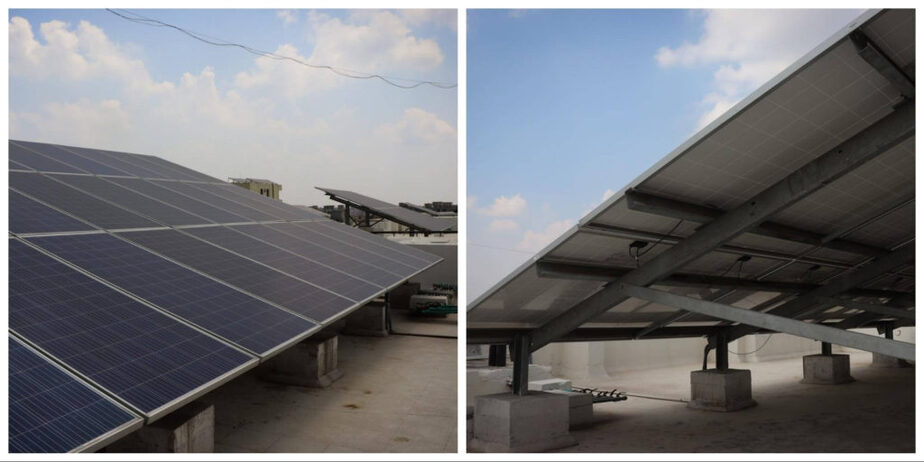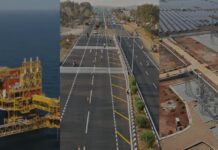Written by Vaishnavi Rathore with inputs from Arnab Chakraborty
The view from one of Dwarka’s apartments initially looks like the typical New Delhi skyline. The horizon is dotted with high-rise apartment buildings, some greenery, a school…and then, something unusual catches the eye: rooftops covered by shiny, sloping panels. These are solar rooftops (SRTs), a relatively new installation under ‘Solarise Dwarka’ where BSES Rajdhani Power Limited is targeting Community Group Housing Societies to generate electricity from rooftops to societies.
“Renewable energy is important for the environment now and we have decided to shift to this,” says Daljeet Singh of Sahela Apartments. As he speaks, the manager of the housing complex, Suman, scrolls his phone to call a worker who has come to install the solar panels in their society today. Their residential complex is set to join the band of a few apartments here in this subcity standing tall in North-west of Delhi, who are producing electricity in their own backyard.

However, Dwarka’s rooftops are a shining example in an otherwise dark sky. When it comes to solar rooftops, the residential sector’s participation (compared to the industrial and commercial sectors) has been the lowest, at 370 MW. This figure is worrying in the face of an ambitious target that India has set itself, which is to achieve 175 GW of renewable energy capacity by 2022. Out of this, rooftop solar photovoltaic is expected to contribute 40 GW. So, is the high up-front cost of installing an SRT a major deterrent?
Rescued by RESCOs
“We have not spent a penny on the installation of the panels,” says Umesh Kumar, manager of Ispatika Apartments, whose 120kw solar rooftop facilitates savings of ₹15,000 to ₹20,000 per month in the electricity bill. “We got it done under the RESCO model”.
The Renewable Energy Services Company (RESCO) model is a tripartite agreement between the government, a residential complex and a company, wherein the company bears the up-front capital cost. Apartment complexes of both Daljeet Singh and Umesh Kumar have a net-feed grid-connected solar system energised by Oakridge Energy. This means that the electricity generated through rooftop panels is fed into the grid which would be credited into the electricity bill of the housing complex. In effect, the complex then pays the RESCO for the energy imported from the grid minus the export of energy. Additionally, the Delhi Government also provides a generation-based incentive (GBI) of ₹2 to consumers for a limited time period. The Delhi Solar Policy, 2016 specifies these provisions.
If the RESCO model has cut down costs for residents, the question still remains: for a sector with high potential, why have residential complexes missed the mark?
Keeping Residential Sector in the Shadows
Sanjay, the manager of Shri Ram Co-operative society, a stone’s throw away from Ispatika Apartments gives an insight, “The representative of the company who visited could not explain to me what the benefits that our society would get would be. I couldn’t get much clarity and that’s why we have not been able to make a decision regarding this yet.” Now imagine this— as a customer, you want to avail some service but cannot find information on where to buy it from. You are also unsure about the service’s potential benefits. Would that be a convincing market experience for you? You would probably leave that service for dead.
The case with solar rooftops is similar; there is limited access to reliable information on companies, many of which are small and new. Resident Welfare Associations worry about the reliability of the technology and the maintenance they require. In Dwarka’s housing society clusters, the installation of SRTs has seen a ripple effect. After Oakridge Energy set up the solar rooftop for one complex, referrals brought friends, relatives and neighbours on board. Outside this tried-and-tested consumer circle, committing to such a technical market can be a daunting proposition.
Interestingly, consumers are not the only ones uneasy to set up an SRT in a residential complex. Even RESCOs have not always shown interest in household markets. “Large companies focus on larger projects,” Mr. Nabanshu Bhattacharya, head of operations at Oakridge, tells me. This focus on large-scale rooftop installations often puts smaller residential projects in the shadows.
“This type of business is very different from the usual,” he further adds. “Usually, in a business project, we know exactly who the end user is. But with housing complexes, a lot of people are involved in decision making. The discussion takes place in a general body meeting, and then post that the work starts.” This hints towards a major disincentive for a RESCO, which is their inability to assess the risk associated with a customer. For instance, can the said housing complex ensure timely payments? Are the installations worth the cumbersome legal processes when payments are delayed? With such deterrents for companies and housing complexes prevalent across major Indian cities, only 2.1GW of SRTs (out of the targeted 40 GW) have been installed as of December 2018.
Towards a brighter Future
Dwarka’s bright future for renewable energy reiterates the success of the RESCO model. While it may have worked for a few housing societies here, the entire market needs more care to thrive.
Some steps to facilitate this ecosystem have already been taken. Shweta Koshi, who works with the Energy Programme of Centre for Science and Environment, tells me, “The RBI has identified solar rooftop as a priority sector for lending. Eight public sector banks have included SRT systems under their housing or housing improvement loans.”
Moreover, Phase II of Grid Connected Solar Rooftop Programme envisions making the distribution companies (DISCOMS) the facilitators of solar rooftop adoption. “Up until now, there were scattered accounts of DISCOMs hindering and even discouraging solar rooftop uptake because it strained their finances and grid stabilization efforts,” Shweta says. “As primary facilitators of the programme, DISCOMs are now incentivized to take charge and this is expected to increase uptake, especially in the residential sector.”
As I walk through Dwarka’s posh lanes and high-rise apartments in the hope of understanding residents’ thoughts on solar rooftops, a security guard excitedly asks me, “Madam, do you get solar panelling done?” In another complex, the manager asked me for the solar panelling proposal even before I could finish telling him what the intent of my visit was. Those residents who are informed are excited about this new RESCO venture. Yet, the next steps must focus on accelerating this inclination and demand while creating favourable conditions to ensure enough ‘supply’. India needs a healthy competitive market for domestic RESCOs. Hopefully, with effective marketing and consumer awareness, more residential complexes will have their rooftops covered with shiny, sloping panels — facing the sunny side up.






